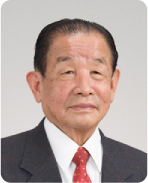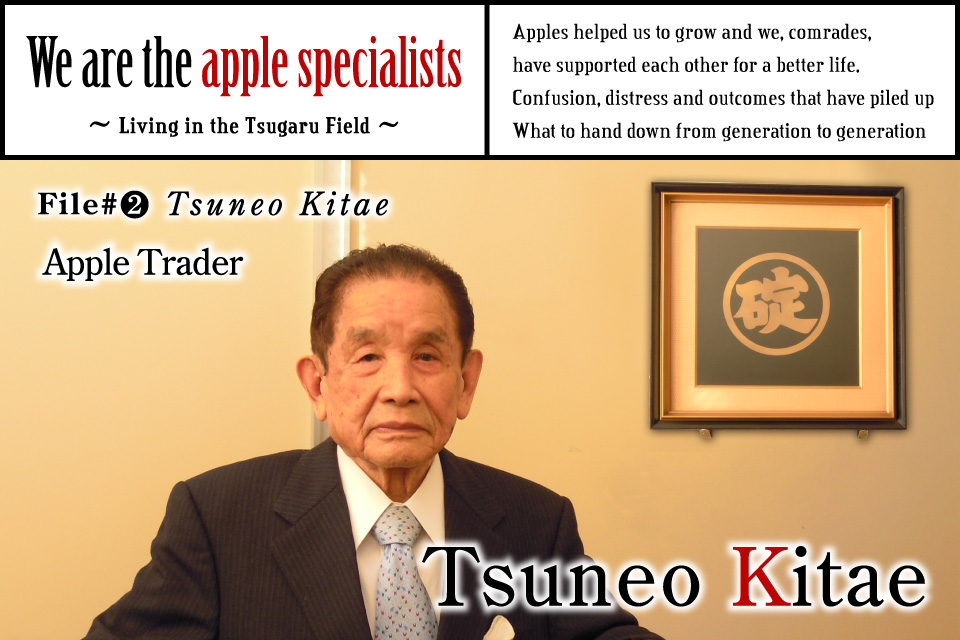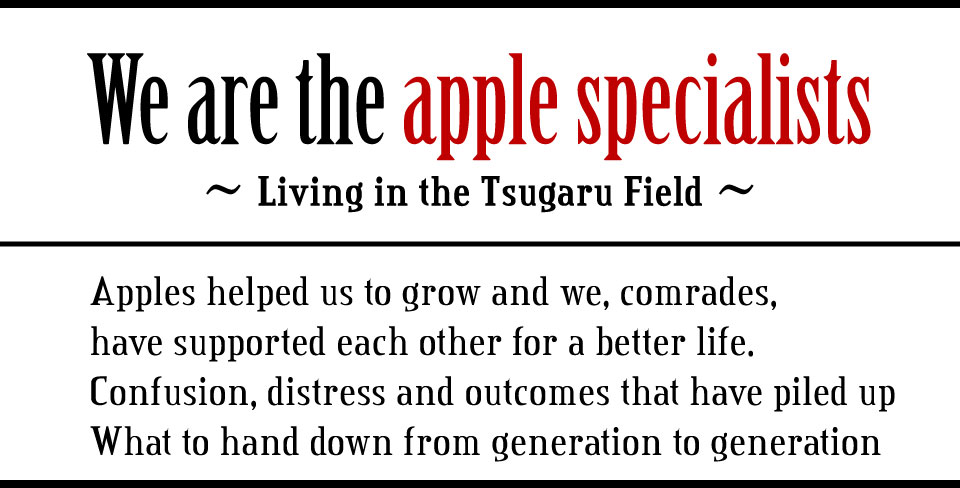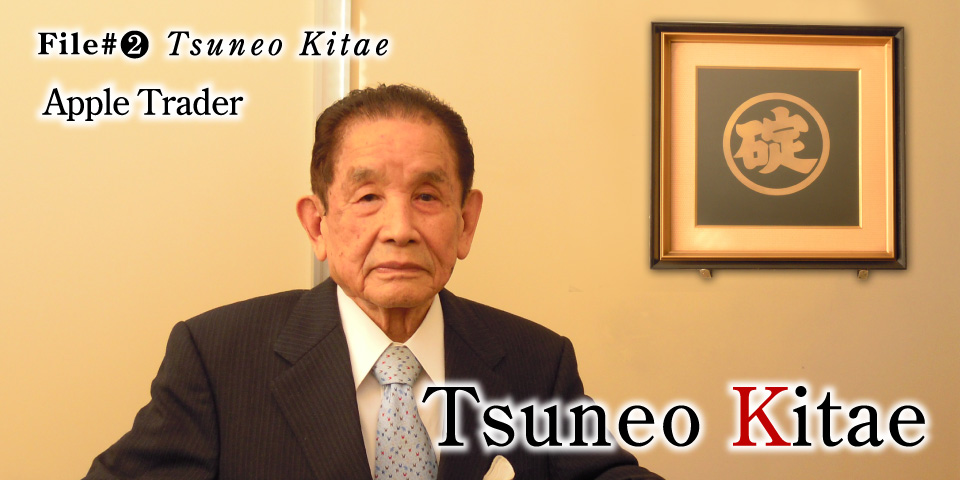<1st Volume> <2nd Volume>→
There’s a man with the solid belief that this business is his calling.
This man, who lived through a turbulent period and headed to the north without any of his belongings,
built a generation after overcoming many obstacles.
The eyes of this man who has loved and been loved by apples still glisten at present.
File#② Tsuneo Kitae <1st Volume>
On Route No. 7 which runs through the city of Hirosaki, there is a huge facility that people catch sight of. It is the “Kitae Apple Co., Ltd.” It is a pretty well-known company among locals and has been the top apple Trader in Hirosaki for many years. The chairman of the board of directors of this company is Mr. Tsuneo Kitae, 95.
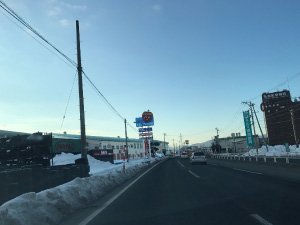
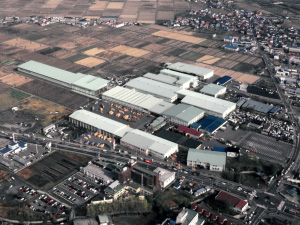
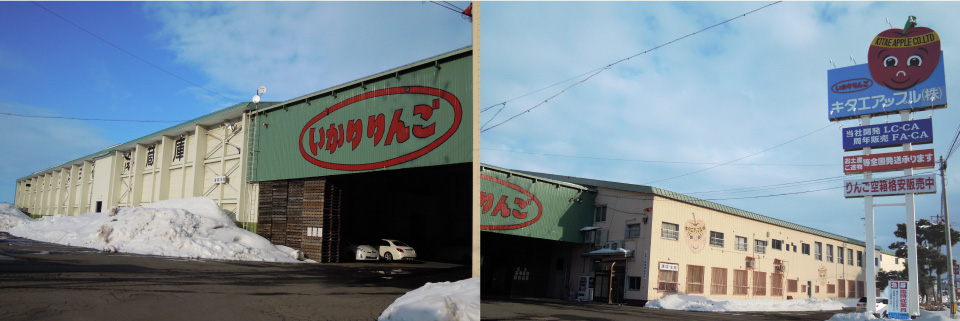
◯ ◯ ◯
He was born on March 24, 1922 on Awaji Island in Hyogo Prefecture. It was the era of upheaval as society was going through the aftermath of the Sino-Japan War, the Russo-Japanese War and WWI. Then, at the beginning of the Showa Era, the bubble economy came to an end with the finish of WWI and the Great Depression started. The people expressed discontent with the government and a series of coup d’etat were conducted. Under these circumstances, a prime minister was elected from the military.
During those days Kitae was broken-hearted, having lost his father at age 13 and his mother at age 15. Then an opportunity arose. Kitae was sent to serve as an apprentice to a distant relative, having lost his parents.
In 1940, in the midst of the WWII era, he turned 18 and received a draft card for the military. However, he had an accident, crashing into a train while driving a tri-wheel motor car.
There were no railroad crossings in those days and he couldn’t see the train because of the woods around the curve. He was with a senior colleague from work in the car.
“I don’t remember how it happened. I heard that I was carried to the nearest hospital and unconscious for 3 days. After my recovery, I was told that the man in my car died on the day of the accident. I was really shocked.”
He himself had broken bones and was severely injured, wrapped with bandages all over his body. The bones were fixed with wire and a painful rehabilitation commenced, without any break. Even after the wounds healed, he couldn’t mobilize his hands and legs, thus he was exempted from military service.
In 1942, when the Japanese military became inferior in power, the military became so desperate that they recruited Kitae as a medical orderly.
Kitae served, trying to carefully treat fallen soldiers. In the course of his service, he learned from the deads’ business cards that many were company executives. He recalls, “If it were in the homeland, they could have been saved and nursed by their family. But I couldn’t help them. I was very sorry for them.”
“The crash was a fate that allowed me to live on to this day. I could return to Japan because I was not sent to the battlefield,” he quietly said.
The Encounter with Apples
In 1945 after the war, Kitae, 23, came back after having served for 2.5 years, and returned to his homeland, Awaji Island. In the chaotic times after WWII, there was a shortage of goods. When a sufficient quantity was in short supply, the prices of goods went up, and thus inflation occurred. To prevent price increases and social and economic confusion, and to stabilize people’s lives, the government declared price controls. It consequently caused people in cities to experience an insufficiency of food. There were food distributions, but it was never enough, and many starved to death. Under these circumstances, people went to farming villages to buy food, knowing it was illegal. Business-minded men started to purchase food to sell, and thus black markets began to appear all over Japan. Kitae himself began to purchase and sell food on the black market; he sold everything, including rice, fish, vegetables and fruit. Once when he visited Nagano for a purchase, he saw apples for the first time. He learned that apple trading could be profitable, so he started to specialize in apples. He grinned and said, “I was questioned by the police a few times because it was illegal then.” But he never quit purchasing apples, going back to Nagano several times. During that period he thought of effective mass transportation methods, instead of moving only small amounts. One of his trading pals suggested that he should go to Aomori where mass production of apples was done, and use trains to transport them. So he decided to head to Aomori, which was his very first step into the region.
He took a train to Aomori, and on the way he heard that Hirosaki was the best place to trade apples. Hirosaki became his destination then. A box of apples cost 300 yen at the time. It was very expensive if you consider that the monthly salary of a bank manager was about 700 to 1000 yen. He planned to buy 300 boxes to load onto a freight train to Kobe. He emotionally recalls the situation then: “I only had 80,000 yen with me and the price was 90,000 yen. But I made a deal to pay back the balance next time. I was impressed with this Hirosaki man’s warm heart.”
So he started to commute to Aomori to buy apples once a month. It was still during the black economy, and if he were to be caught by the police, he would have lost everything. It was an extremely risky business, but he was luckily never caught and he continued moving back and forth between Kobe and Hirosaki for a few years. He sold a box of apples for just 400 yen, having bought it for 300 yen. He had a sense of insecurity about the business that perhaps it wouldn’t last so long.
The underlying cause of the uneasiness for him was the Japanese economy that Kitae experienced as a child. During WWI when the shipping company businesses were active carrying various goods, some of them were called “shipping millionaires” because of the boom. However, the economy went down with the end of the war and many companies went bankrupt. So he worried that post-war hard times would start again. He decided to safeguard his property by dividing it into three parts - cash, stocks and real estate, predicting the downward trend of economy. Soon his uneasiness became real. The government lifted price controls. A disinflation policy called “Dodge Line” caused money to tighten and headed the economy into a depression called the “Stabilization Crisis.” With his keen foresight of the economy, he managed to save cash and real estate, although he lost stocks. (The property in Kobe had been sold.) “I was an inexperienced young man being trapped,” he said. Because of the lifted price controls in the recession, he could not continue the black market business any more. Until then the business was conducted with set prices, owing to the price controls. He had to commit to a new decent business in order to survive in the free market.
He thought over how to survive the shaky economy. He concluded that he would become an apple trader in Aomori. He planned to start the business using his remaining cash and real estate. Since he continued to go back and forth between Hirosaki and Kobe, he thought that apple trading should be his one and only mission. When he consulted his friend one day, he was told, “You should not think of going back to your hometown when you make enough money. You should really become part of the earth in Aomori to be successful.” With those words, he decided to do business here for the rest of his life.
Started as an apple trader
In 1950, at age 28, Tsuneo Kitae established Kitae Shoten in front of Hiraka Station. There were several reasons why he picked Hiraka. One, there was heavy competition in Hirosaki because of many apple traders, which made it difficult to keep a freight car. At Hiraka Station he was able to load apples on a freight vehicle with priority if he also carried wood and chaff, and unloaded the cargo from the car. Also, it was convenient to load apples from the store near the station and the warehouse was built close to the store. Without refrigerating facilities, in those days apples were boxed using chaff as cushioning. And in winter they were stored in snow storage chambers. Kitae started studying refrigeration in order to sell apples for a longer period during the year. He was also particular about packing. There were two types of fruit sorting machines that existed then: one by weight and one by shape. Both had their merits and demerits, so the final sorting was done by workers’ eyes. “Customers are happier if the apples are packed neatly. We paid careful attention to precisely fit them into the boxes using mm units. I also learned by looking at how other people were doing it,” he said. Packing methods differed depending on the individual and there wasn’t any set style, but he tried to give value to the appearance so he could sell at higher prices. Apples at that time were pretty expensive fruit, and the display of apples at the opening of the box mattered a lot. Considering both customers and the workers’ workload, he paid attention to how high he could pile the boxes. This attentiveness and the ability to take action became the key to his success from this time forward.
His family was living in Kobe while he was alone in Aomori managing the company, for the sake of his children’s education in a warmer place.
The business wasn’t going well at first. As a stranger, Kitae had some problems with locals and experienced hindrances. The street from his warehouse to the station was narrow and the neighbors’ eaves extended outside, so the trucks sometimes damaged them when passing through the street. He, of course, compensated for them when it occurred. All things considered, eaves were sticking out into public spaces. He had a talk with the neighboring people in protest using a middleman, but he was told that the middleman had to take the side of the Aomori citizens, even though he understood Kitae’s reasoning. He recalled, “I had a hard time with the relationship with others in Hiraka.”
Also, he was surprised at the severe winter coldness. Once he visited an apple farmer in a snow storm; it was a so-called “white-out.” For people in Aomori it is common knowledge that you cannot breathe in a white-out. But it was beyond Kitae’s imagination that people could live in this icy weather, and he felt the power of the people in the north. It was completely different from that of Awaji Island or Kobe. Getting over the years of coldness, he now says, “The winter in Hirosaki is within this degree.”
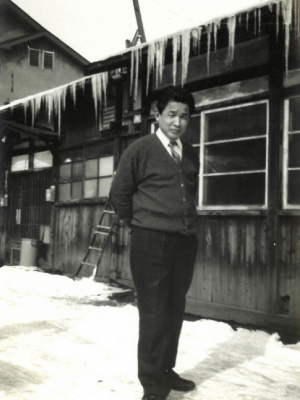
Kitae Shoten, Hiraka
In 1955, after having run his business for 5 years in Hiraka, there was a fire near his store. It was a big fire, scorching the entire area including his warehouse. He was shocked by it, but he never gave up his business; he now had some experience and was getting actual results. He tried to reconstruct his business with the help of insurance money. At this time he decided to move to Hirosaki with the hope of expanding his business.
He chose Higashi Watoku, Hirosaki. It was the closest place from the station among the available lands. The price of the property was fairly low. And he learned that the area claimed for his business was about 3000 tsubo (tsubo: a unit of land measurement, 3.3 square meters). There were a little over 2000 tsubo and an 800 tsubo lot just across the street. He had a feeling that he could manage to get along there. He constructed the refrigerated warehouse that he had longed for years before. It was the earliest one to be built among apple traders. He was 33 years old then.
Disease
Two years after moving to Higashi Watoku, he had a health check-up in Kobe while staying with his family. His wife strongly recommended having one since there were two deaths caused by stomach cancer among relatives. He had one, just in case. They found that he had lung tuberculosis. It was called an incurable illness during the prewar and war periods. Antimicrobial therapy had just started and some had recovered from the illness. However, Kitae was severely ill. The doctor told him, “How could you walk like that. I’ve never seen a man in such a serious condition in recent years. You are going to be hospitalized right away.” Until then he was spending days without any symptoms. But he said and smiled wryly, “Strangely I felt sick once I heard the doctor say it.”
So he entered the sanatorium. Even though he was seriously ill, he didn’t feel any symptoms. He started to think about his business and he begged the doctor to be discharged. He needed to go back to Hirosaki. At first the doctor turned down the demand, but he begged to be discharged under the condition of hospitalization in Hirosaki.
He continued the apple business in Hirosaki while receiving treatments. In those days, the specific medicine for TB was said to be effective for only 6 months. Three months had passed since he took the medicine in Kobe. He realized he had subjective symptoms, and prepared for the worst in three months. He finally realized that he could not stay in Hirosaki in his current condition. He decided to take action before he neared death. He thought of two things: the refrigerated warehouse as a property and his family in Kobe. He lent the warehouse to the merchants union in Hirosaki to earn money to pay the loans and provide for his workers. He meant to spend the time, no matter how long it took, to cure his disease, and he returned to Kobe to receive treatments.
The ward he entered in the hospital in Kobe was for severely ill patients. Kitae asked the doctor, “If I should stay in this room, I would become worse. I need to be transferred to a room with milder patients.” But the doctor persuaded him, “Your stage is the same as that of the people in this room. You will be transferred to a different room when you get better. Please just rest and gain energy.” Then Kitae realized the severity of his condition and decided to listen to his doctor as much as he could.
The fact that all doctors and nurses wore surgical masks in the ward made him realize how critical his condition was. His wife visited him every day without a mask and drank tea from his used cup. He worried and said, “What if you get the disease? Our children might catch it from you.” His wife replied, “You should chase away such a weak mind in order to bring back your good health. Everyone has this curative power. My sister suffered and died of tuberculosis in a hospital. I also have a shadow in my lung, but I’m doing fine. You can recover from it no matter how long it takes.” He couldn’t stop crying when he heard her words. “If I were in her place, I wouldn’t be able to use the same cup to drink. So since then, I’m no match for my wife,” he commented wryly.
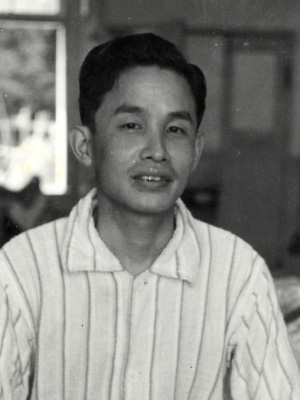
Kitae in bed
Appreciation
Two months had passed, and Kitae felt himself weakening day by day. Meanwhile, he found an article in a magazine which was about an effective folk remedy for tuberculosis. It was the method of inhaling sesame oil into the lungs. “I consulted the doctor about it, but he was against this remedy. It was a matter of course since it’s not medical at all. But I felt optimistic about it,” he said. Desperately, he decided to try it anyway and continued daily. It wasn’t effective at first, but half-believing and half-doubting, he went with his intuition to try and cure himself. Tubercule bacillus remained after a year of the remedy. He called the method’s company executive to his presence and asked him about it directly. He answered, “Your condition is too bad to cure quickly; it will take longer. But I’m sure that the bacillus will die out.” He felt convinced after meeting with this person and decided to continue.
After six more months, he was told that no tubercule bacillus existed. He couldn’t believe it himself, but the bacillus was gone. The doctor said it was a miracle.
He had survived the train accident and returned from the battlefield because of his service as a medical orderly. And now, he had recovered from his serious illness. “There was enough reason to be blessed,” Kitae said with indescribable feelings.
He recuperated from the severe illness well and was transferred to a milder ward. One day when he moved into a room of milder patients, the man next to him had asthma. He was annoyed by the coughing so much that he could not stand it. Whenever the man was away at the toilet, he was relieved to not hear a fit of coughing. Moreover, he began having a hard time sleeping at night and complained about it to the doctor. Finally he was transferred to a room of minor symptoms, in consideration of his steady recovery.
In this room he felt comfortable for a few days. But a train ran near the building. He started to become concerned with the noise of the railway. The train made him sick every time it passed. He consulted a doctor and was sent to a specialist of mental illness, a man of religion. The man told Kitae, “You should appreciate everything from your heart. You are too selfish. Try to see other perspectives. You might think the train is too noisy. But what if it didn’t exist? People would have trouble living. It’s indispensable for us to live and improve our lives. We all owe our living to others. We must think of everyone’s benefit. You should take this into account and keep an appreciative mind.”
From then, every time he heard the train he chanted like a prayer, “Thanks, thanks. I appreciate it.” He kept doing it 24-7, and after a week he felt like he was seeing rays of sun shining down because he was no longer concerned about the train. He was able to stand the sound of the train. Because of this experience, having a thankful heart has become one of his beliefs.
He had completely recovered from his illness both physically and mentally and in 1960, after 3 years from the onset, he was finally discharged from the hospital.
Return from the sickbed
During the 3 year hospitalization, the business was completely closed. It was also a slow period for apple Trader. In 1961 Kitae returned to Hirosaki, and there was a ground swell of business, as if the previous three years had been an incredible nightmare. People of the industry said, “The business had been slow while you weren’t here. The sales were bad. But it seems to have a good tide this year. You are such a lucky guy to come back at this time.” Kitae recalls that he was lucky in terms of all the incidents he had met. He survived his injury from the train accident and the injury helped him avoid being directly involved in the war. And a miracle recovery from a terrible illness followed. During his three year hospitalization, the industry was at the bottom, but rose with his return. He believes all these incidents made him prosperous.
During his recuperating years, the apple transport industry was dull. But he was confident that the economy would recover soon with the help of empirical rules. He had foresight, so to speak. As he predicted, the industry started growing. However, the other apple traders’ management conditions were severe because of the previous years’ dull business. Since Kitae had closed his company for three years, he worried about getting a loan from the bank. There was of course a credit line set by the bank. On top of his three-year absence, he was anxious about how much he could borrow. He talked with the bank officer in charge of loans and explained how well the apple business had recovered from the bottom in the following year. He desperately requested a loan. The bank trusted him for his prospects and allowed him to borrow a credit line of two to three times as much as normal. There were only two, including him, to receive that much credit at that time. “I was very delighted that the bank saw my promising future in this business,” he looked back and said. Although he was in bed and out of business for three years, he could loan two to three times as much of a credit line. He decided to try his best then. Fortunately, during the next year his efforts led to a great success. He again received credit for his prospects and earned trust from the bank.

Kitae after hospitalization
Written in February to March 2017
Released June 2017
Profile : Tsuneo Kitae
